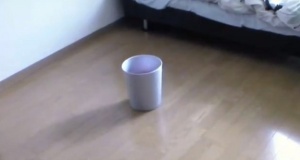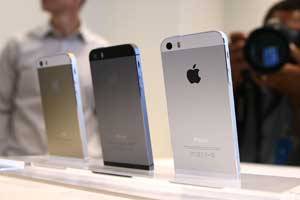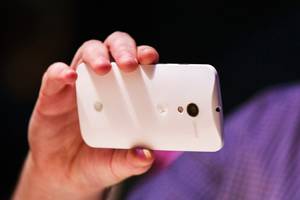A Japanese engineer has created a trash can that moves on its own to catch your trash. Developed by Minoru Kurata, the device features a wall-mounted sensor that detects which direction the trash is coming from. A computer then calculates the thrown trash’s trajectory and moves the trash can so the item will land inside the can. The invention won an Excellence Award at the Japan Media Arts Festival.
TEETH THAT CAN THINK
Scientists at Princeton and Tufts are working on a super thin tooth sensor (a kind of temporary tattoo) that sends an alert when it detects bacteria associated with plaque buildup, cavities or infection. It could also notify your dentist, adding an extra layer of social pressure to make an appointment. The sensor may have wide-ranging use: the researchers have already used it to identify bacteria in saliva associated with stomach ulcers and cancers. While the sensor won’t last long on the surface of a well-brushed and flossed tooth, Michael McAlpine, the project’s leader, says that the sensors will be inexpensive enough that you can replace them daily. Clay Risen
ELECTRIC CLOTHES
Physicists at Wake Forest University have developed a fabric that doubles as a spare outlet. When used to line your shirt — or even your pillowcase or office chair — it converts subtle differences in temperature across the span of the clothing (say, from your cuff to your armpit) into electricity. And because the different parts of your shirt can vary by about 10 degrees, you could power up your MP3 player just by sitting still. According to the fabric’s creator, David Carroll, a cellphone case lined with the material could boost the phone’s battery charge by 10 to 15 percent over eight hours, using the heat absorbed from your pants pocket. 
BlackBerry launches Passport smartphone
BlackBerry launched an unconventional new smartphone dubbed the Passport on Wednesday as it embarked on what may be the most critical phase of its long turnaround push.
At simultaneous events in Toronto, London and Dubai, BlackBerry showed off the device, which is the size and shape of a closed passport, with a large square touchscreen as well as a keyboard.
The Passport comes to market as the phones of BlackBerry’s rivals converge on a single profile, with tall, rectangular screens and smooth corners. Users can type on the Passport’s keyboard to enter text, or swipe lightly across it to navigate through the phone.
BlackBerry recently concluded a three-year restructuring process, and it is now up to chief executive John Chen to prove that the company’s new devices and services are capable of generating sustainable new streams of revenue and returning it to profit.
“BlackBerry is still fighting for survival. They still need to turn around and develop a viable ongoing business model,” said Brian Colello, analyst at US investment firm Morningstar.
“Their products are certainly pointing toward that and the new strategy makes sense, but there is still a lot of execution risk at this point in a very competitive market.”
At the Toronto event Chen brought out retired National Hockey League star Wayne Gretzky to talk up the Passport’s features. The device has a suggested introductory retail price of $599 (£367) in the United States.
BlackBerry said the new smartphone should be available in more than 30 countries by the end of the year. It will be carried by AT&T in the United States.
Passport users will be able to download apps from Amazon’s app store, previously only available for Android-based phones. BlackBerry announced the deal that cleared the way for its customers to access Amazon’s store in June.
The launch kicks off a busy period for Ontario-based BlackBerry. The company is set to report its second-quarter results on Friday and within a couple of months it is also expected to launch the long-awaited BlackBerry Classic, which bears similarities to its once wildly popular Bold smartphone.
“BlackBerry just needs one hit phone for now,” Colello said. “It doesn’t quite matter whether it is the Passport, the Classic or anything else, but they do need one device to jump-start the hardware business again.”
The company hopes the Classic and the launch of its new mobile device management system – BlackBerry Enterprise Service 12 (BES12) – will help it claw back ground ceded to rivals in both the hardware and services market.
The BES 12 platform will allow IT managers at large companies and government agencies to not only manage and secure BlackBerry devices, but also manage Windows-based devices, and more easily administer Android and iOS devices.
Chen, a well-regarded turnaround expert in the tech sector, wants BlackBerry to remain a competitor in the smartphone arena, but he is focused on reshaping the company to build on its core strengths in areas such as mobile data security and mobile device management.
BlackBerry is betting that the enhanced security features on its BES 12 platform, coupled with a range of value-added services, will help revive revenue growth and stem its slide
E-Zone to Open E-Commerce Website by Month-End!
Future Retail has said it will be introducing an online platform ‘omnichannel’ for its electronics store E-Zone in a fortnight to cash in on the festive season.
“We will introduce omnichannel to E-Zone by this month-end through which we sell electronic products like cellphones and television sets as people mostly buy these items during the festive season for gifting purpose,” Future Retail Joint Managing Director Rakesh Biyani told PTI in Mumbai.
Omnichannel involves selling products through multiple platforms like mobiles, online and brick and mortar stores.
Biyani said the company earlier this month tied up with German enterprise resource planning company SAP to facilitate the launch.
“Keeping the forthcoming festive season in mind, we have created a huge space for our customers through omnichannel.”
Meanwhile, flush with funds, the e-tailing segment is gearing up in a big way for the festive season by launching aggressive offers and discounts for customers. Snapdealkicked off its festive season’s bumper sales.
“We are starting off our bumper sales from today. We will bring great products, great offers to our customers during this festive season,” Snapdeal founder Kunal Bahl said.
One-and-a-half years old e-grocery firm, Localbanya, plans to diversify its range of products.
“We are planning to increase the number of products to 20,000 over the next six months from the current 14,000. We do believe that the festive season increases the need for staple products,” Localbanya co-founder Amit Bhartiya said.
Teen makes device to turn breath into words, enters Google science fair!
GURGAON: Arsh Shah Dilbagi, a 16-year-old from Panipat, has entered the Google’s Global Science Fair as the only finalist from Asia this year for developing a device that helps people with developmental disabilities, like Locked-In Syndrome and ALS, communicate, using only their breath.
The device, called ‘TALK’, uses signals from a person’s breath via Morse code, picked up by a sensor, and then converts them into speech. Dilbagi, a student of DAV International School, Panipat, says the device even allows almost entirely speech impaired and paralyzed people to communicate like never before.
Claiming to have built the world’s fastest and cheapest Augmentative and Alternative Communication (AAC) device, a kind used by physicist Stephen Hawking, Dilbagi says it is not possible for all those who have motor-neuro disabilities to afford an AAC device that costs $7,000 (Rs 4.26 lakh).
“AAC devices available in the MARKET are very expensive, slow, bulky and not generic. I decided to find a better solution — an AAC device which is faster, portable and generic and costs only $80 (Rs 5000), making it affordable to the large population,” he explains.
The young innovator says that TALK expects a person to be able to give two distinguishable exhales with varying intensities, for converting them into electrical signals using a microphone. The signals are processed by a microprocessor, called the ‘Morse engine’, which labels the short exhales as ‘dots’ and longer exhales as ‘dashes’. These are further interpreted through the Morse code which converts the signals into words and then sends them to another microprocessor for synthesizing them into voice. According to Dilbagi, TALK features two modes – one to communicate in English, and the other to give specific commands and phrases. These are communicated in nine different voices enabled according to gender and age.
Making two major breakthroughs; increasing the speaking rate, and becoming the world’s most affordable AAC device, TALK has landed the young prodigy as the only finalist from Asia in Google’s Science Fair Challenge.
“I even got predicted results by testing the device on a person suffering from encephalopathy (global brain dysfunction) and Parkinson’s disease,” he has claimed in his proposal to Google.
He adds, “In future, I would like to add auto-predictions to my computing engine and integrate TALK with modern technology like Google Glass to make it easier for people with development disabilities.”
Dilbagi’s father, Amit, said, that since childhood his son had dreamt of doing something meaningful for mankind.
“His attention has always been towards applied science projects. I will request Prime Minister Narendra Modi and Union health minister Harshvardhan to consider this project for the countless people in need for such a device in our country,” he told TOI.
Google working on super-fast ‘quantum’ computer chip!
Google Inc said a research team led by physicist John Martinis from the University of California Santa Barbara will join the company to start a project to build new quantum information processors based on superconducting electronics.
The Quantum Artificial Intelligence Lab is a collaboration between Google, NASA Ames Research Center and the Universities Space Research Association (USRA) to study the application of quantum optimization related to artificial intelligence.
With an integrated hardware group, the Quantum AI team will now be able to implement and test new designs for quantum optimization and inference processors based on recent theoretical insights as well as our learnings from the D-Wave quantum annealing architecture,” Google’s director of engineering, Hartmut Neven, said on its research blog.
Google, which is working on projects including self-driving cars and robots, has become increasingly focused on artificial intelligence in recent years.
Earlier in January, Google acquired privately held artificial intelligence company DeepMind Technologies Ltd.
New Apple iPhone to have “mobile wallet” function: Report
Apple Inc plans to enable its next iPhone to become a mobile wallet by allowing owners to securely make mobile payments in a store with the touch of a finger, Bloomberg said on Sunday, citing a person familiar with the situation.
by allowing owners to securely make mobile payments in a store with the touch of a finger, Bloomberg said on Sunday, citing a person familiar with the situation.
The agreement includes participation by Visa Inc., MasterCard Inc and American Express Co and will be announced Sept. 9 along with unveiling of the next iPhone, according to the source, who Bloomberg said asked not to be identified because the talks are private ..
Gadgets to watch out in 2014
It’s almost fall, which means tech companies are gearing up to release their newest smartphones, tablets, and wearable gadgets in time for the holiday season.
Most manufacturers haven’t even unveiled these devices yet, but we already have a pretty clear idea of what the most popular smartphones and tablets of 2015 will look like.
It’s important to keep in mind that these devices haven’t been confirmed yet, so there’s a chance that some of the phones and tablets on this list may not make it to market in 2014.
However, based on numerous rumours and leaks over the past few months, we feel strongly enough to include them in this list.
1. iPhone 6
Apple’s next smartphone, presumably called the iPhone 6, is probably the most anticipated gadget of 2014. The phone is expected to come out at the end of September, and Apple will reportedly unveil it on September 9.
Based on various leaks and rumours, it seems like the iPhone 6 be a noticeable upgrade from the iPhone 5s. The iPhone 6 will reportedly come with a larger, sharper 4.7-inch screen and a completely new design that looks similar to the iPad Air than an iPhone.
2. An even larger 5.5-inch iPhone
It’s been widely reported that Apple will unveil two new smartphones this year – one with a 4.7-inch display and another with a 5.5-inch screen. It’s unclear if they’ll both launch at the same time, however. Some reports have indicated that Apple has run into production issues with the 5.5-inch iPhone, hinting that it could be released in late 2014 or early 2015.
3. Samsung Galaxy Note 4
Samsung is reportedly getting ready to unveil its new Galaxy Note smartphone in early September. Like the Galaxy Note 3, the Note 4 is expected to come with a giant 5.7-inch display.
We wouldn’t be surprised to see a Galaxy Note 4 that looks like a giant version of the Galaxy S5, which means it could come with the same dimpled back and a heart rate monitor. We won’t know for sure until Samsung makes an official announcement, which is expected to happen on September 3.
4. Google Nexus 6 (or Nexus X)
Google is also reportedly preparing to release a new smartphone this fall. A report from TKTechNews suggests that it could launch in September, and that Google may call it the Nexus X rather than using its traditional numbered naming convention. Google’s new Nexus phone is expected to be more premium than the company’s previous Nexus phones.
It may cost somewhere in the $499.99 (Rs 30,000 approximately) range (unlocked) compared to the $349 Nexus 5. Naturally, it’ll ship with Android L and is rumoured to feature a 13MP camera, a 2K display, and a Qualcomm Snapdragon 805 processor.
5. Moto X+1:
There’s a strong chance that Motorola’s next flagship smartphone, presumably the Moto X+1, will debut in September. The company is holding an event on September 4, where it’s expected to officially take the wraps off its new phone and a few other gadgets, too. The Moto X+1 is expected to come with a larger, sharper display than the Moto X, a faster processor, and a dual-flash camera.
6. Second-generation iPad Air
In years past, Apple has unveiled its new iPads in October, leading many to believe that an update to the iPad line is coming this fall, too. We haven’t heard too much about the second-gen iPad Air, but a report from Korean news source ET News suggests Apple may already be working on its components.
If the report holds up to be true, we could expect to see a new iPad with the same design as the first Air, a faster processor than Apple’s current tablet, and a better camera. French blog Nowhereelse.fr also posted a leaked image that claims to show the ipad Air 2.
7. A new Nexus tablet from Google :
Google is also rumoured to be working on a new gadget with HTC, and many believe this will be Google’s new Nexus tablet. From what we’ve heard, it sounds like this new device will be a tablet version of HTC’s One smartphone.
Codenamed “Volantis,” the tablet is expected to come with a super sharp display, HTC’s aluminium design that’s become the staple of its new smartphones, and Android L right out of the box. There’s no word on when it will come out, but Google has previously unveiled its new Nexus hardware in the fall.
8. Apple’s iWatch
Apple has been rumoured to be working on its first wearable device for more than a year, and a report from Re/code suggests it could finally debut this October. The iWatch is expected to focus on fitness, and will supposedly be able to track the number of steps you take, how many calories you’ve burned, and your heart rate, among other information.
If Apple does unveil the iWatch in October, we can probably expect to see it go on sale by the end of the year.
9. Moto 360
Motorola’s Moto 360 is one of the first devices to use Google’s new software for wearables, Android Wear. It made headlines back in March when Motorola unveiled it thanks to its circular design, which is unusual for a smartwatch with a touchscreen.
The Moto 360 is water-resistant and supports wireless charging. There’s no word on how much it costs yet, but Motorola is expected to unveil more details about availability on September 4. Rumours suggest it will retail for about $250.
Google Recent Innovations – Internet balloons
Google’s think tank has created an innovative solution to the problem of low web penetration in developing countries – balloons that beam down internet. As part of its Project Loon, Google sent out balloons that float in the stratosphere at a height of 20km and relay the internet to houses via a special antenna that captures the necessary signals.
The internet search titan aims to provide 3G-like speed via these internet balloons, which cover an area of 1,256 sq m each. Seeing an innovative and eco-friendly means to solve the problem of poor internet connectivity, several nations (including India) have shown keen interest in Google balloons.









